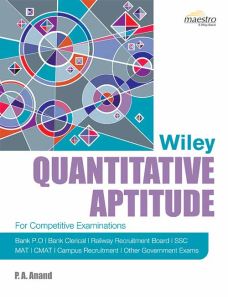Wiley's Quantitative Aptitude
ISBN: 9788126549306
408 pages
eBook also available for institutional users
For more information write to us at: acadmktg@wiley.com

Description
Quantitative Aptitude forms an integral part of examinations conducted for campus placements, entry into banking sector, civil services and to public sector services through SSC (staff selection commission) examination. This book focuses primarily on the preparation of Bank P.O and clerical examinations, SSC, RRB, CSAT, campus placements and entrance to tier II MBA courses.
Preface
About the Author
Note to the Students
1: Number System
1.1 Introduction
1.2 Understanding Numbers
1.3 Conversion of a Number from Non-terminating and Repeating Decimal to the Form p/q
1.4 Some Other Categorization of Numbers
1.5 Divisibility Rules of Numbers
1.6 Rules to be followed for Remainders
1.7 Factors, LCM and HCF
1.8 Concept of the Last Digit
1.9 Alpha-Numerals
2: Percentages
2.1 Introduction
2.2 Percentage Equivalent of Fractions
2.3 Concept of Multiplication Factor
2.4 Base and Base Change
3: Profit, Loss and Discount
3.1 Introduction
3.2 Method of Weighted Average
4: Simple Interest and Compound Interest
4.1 Introduction
4.2 Simple Interest
4.3 Compound Interest
4.4 Concept of Effective Rate of Interest
4.5 Difference between SI and CI at the End of Two Periods
5: Ratio and Proportion
5.1 Introduction
5.2 Properties of Ratios
5.3 Applications of Ratios
5.4 Proportionality and Variation
6: Average
6.1 Introduction
7: Ages
7.1 Introduction
7.2 Problems on Ages
8: Alligation, Mixtures and Solutions
8.1 Introduction
8.2 Alligation
8.3 Replacement of Part of a Mixture
9: Time, Speed and Distance
9.1 Introduction
9.2 Basic Concepts
9.3 Problem Types Based on Time, Speed and Distance
10: Time and Work
10.1 Introduction
10.2 Problems Involving Individual Efficiencies
10.3 Problems Involving Group or Combined Efficiencies
11: Basic Algebra
11.1 Introduction
11.2 Basis of Classification
11.3 Linear Equation
11.4 Quadratic Equation
11.5 Progressions
12: Permutation and Combination
12.1 Introduction
12.2 Fundamental Principle of Counting
12.3 Concept of Combination
12.4 Permutation
13: Probability
13.1 Introduction
13.2 Elements of Probability
13.3 Problems Types Based on Probability
14: Set Theory
14.1 Introduction
14.2 Representation of a Set
14.3 Venn Diagrams
14.4 Types of Sets
14.5 Subset of a Set
14.6 Operations on Sets
15: Clocks
15.1 Introduction
15.2 Concept of Clocks
15.3 Other Important Concepts of Clocks
15.4 Concept of Incorrect Clocks
16: Calendar
16.1 Introduction
16.2 Concept of Odd Days
16.3 Definition of a Leap Year
16.4 Counting Odd Days
16.5 Concept of Total Odd Days in 100, 200, 300 and 400 Years
16.6 Problems-Types Based on Calendars
17: Logarithms
17.1 Introduction
17.2 Important Formulas of Logarithms
18: Indices
18.1 Introduction
18.2 Fractional Indices
18.3 Rules for Indices
19: Mensuration
19.1 Introduction
19.2 Cuboid
19.3 Cube
19.4 Cylinder
19.5 Cone
19.6 Sphere
19.7 Mensuration Problems Based on Different Geometric Figure
20: Data Sufficiency
20.1 Introduction
20.2 Structure of a Data Sufficiency Problem
20.3 Approach to a Data Sufficiency Problem
21: Data Interpretation
21.1 Introduction
21.2 Concepts in Data Interpretation
Solved Examples
Practice Exercise
Answer Key
Answers and Explanations
Mock Test 1 to 9

